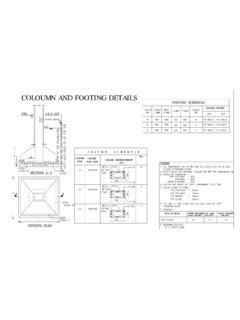Transcription of TM STANDARD DETAILS
1 Partners. Better Products. Better Outcomes. STA NDA R D D E TA ILSTMCorTek is a stay-in-place modular form system, engineered to simplify and accelerate the construction of reinforced concrete stair and elevator core : Factory-built, high tolerance, all-steel construction Rapid, simplified erection procedure Reinforcement steel is pre-installed at the factory Stairs are pre-installed at the factory, providing early trade access to the building floors The form system can support limited construction loads prior to placement of concrete Connections for floor and roof framing are pre-installed Compatible with steel.
2 Concrete and wood framing Structurally equivalent to 8 - 12 CIP concrete wall CorTek modules go up with floor framing CorTek modules do not require stripping Corrugated steel surface can be left exposed, painted, or covered with almost any architectural surface materialFree up site schedule and resources by modularizing core off site in a specialized factory set up for quality and efficiency: Stay-in-place modular form system for concrete core structures Factory built modules stack like building blocks Custom-built to the specific requirements of each projectFaster, Safer, Higher Quality and Cost Competitive.
3 Framing does not wait for cores Immediate presence of stairs allows trades early and safe access to structure Elimination of many dangerous field operations Reduction of poor fit-up and coordination programs among trades Cost comparable to conventional cast concretePlease contact the CorTek Team for more information at Stay-in-Place Access Core Forming SystemDesign Team Quick ReferenceThe following is a quick list of items that need to be decided by the design team and given to CorTek sub-contractor to begin shop Architect and Structural Engineer are responsible for producing drawings and specifications which define the requirements for the core walls and stairs in the final constructed form.
4 The Structural drawings should include: Elevation views of all core walls, dimensioned for all geometry and annotated with reinforcement requirements (vertical and horizontal sizing and spacing). Vertical bars will be spaced at 8 or 16 increments. Horizontal bars should be spaced similarly or at some interval of 4 . Nominal thickness of the core walls. This is the design thickness required by the EOR for the shear wall design. Typical thicknesses would be 8 , 10 , and 12 nominally. The overall thicknesses of these walls would be 10 , 12 , and 14 respectively.
5 Core elevations will also define opening sizes and locations off of grid. Define the top of foundation walls supporting the core walls. Typically a minimum of 6 below the top of floor level slab so that the connection between the core wall and foundation wall is hidden below the top of slab. Define the preferred connection between the core walls and the foundation walls. Typically there are embed plates or rebar form-savers in the top of the foundation. Define DETAILS of all connections as they relate to the core walls. This includes the gravity and lateral load path.
6 Final embed design will be performed by the CorTek consultant (provided by Vulcraft). Define any construction loads to be supported by the CorTek form modules. Provide factored reactions of beams framing into concrete Architectural drawings should include: Any geometry of the stair cores not defined by the structural drawings Stair layouts, including rise, run and plan dimensions. See the CorTek Reference DETAILS document for guidance on how to layout clear dimensions. Stair construction requirements, including railing type Performance specification for the stair design2 Table of ContentsDynamic Plan Reinforcement Section Schedule Type Type Type Type Type Type Plain Type Connection Section Connection Section Connection Section CC Column Section Reinforcing Section Detail Rebar Mat Joist Connection with Connection with Rebar Beam blocks are available for all DETAILS click on the.
7 Dwg file name on each page to download the corresponding block. DATE: 10/17/2017 DYNAMIC PLAN BLOCKTMCORTEK DYNAMIC ,10 , OR 12 WALL3 OR 4 WALL CONFIGURATIONThis block is designed to be used to represent CorTek cores in plan drawings. The rebar and deck flute locations are for representation only. The block can be adjusted for different wall thickness and number of walls via drop down menus. The size can be adjusted with the length and width grips. 4 DATE: 10/17/2017 TMWALL REINFORCEMENT REINFORCEMENT ZONES5 DATE: 10/17/2017 TMREBAR DETAILS6 DATE: 10/17/2017 TMREBAR SCHEDULE EXAMPLEREBAR : 10/17/2017 WALL TERMINATIONTMWALL : 10/17/2017 SECTION C-CTMSECTION : 10/17/2017 SECTION C-C ALTTMSECTION CC : 10/17/2017 SECTION D-DTMSECTION : 10/17/2017 SECTION E-ETMSECTION : 10/17/2017 TMSTANDARD JOIST JOIST CONNECTION29 DATE: 10/17/2017 TMSLAB CONNECTION WITH HASSLAB CONNECTION : 10/17/2017 SLAB CONNECTION WITH REBAR COUPLERTMSLAB CONNECTION : 10/17/2017 STANDARD BEAM CONNECTIONTMSTANDARD BEAM



